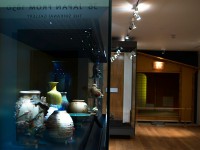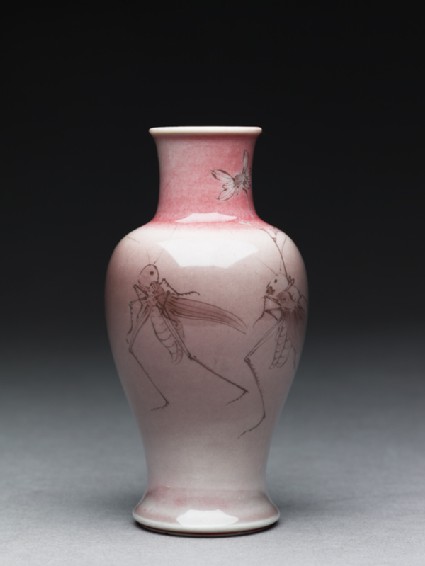Room 36 | Japan from 1850 gallery
Explore the major technical and creative developments in arts and crafts of Japan after 1850 and visit the Ashmolean's tea house.

Galleries : 85 objects
- Reference URL
Actions
Baluster vase with a procession of insects
-
Details
- Associated place
-
Asia › Japan › Honshū › Kantō › Kanagawa prefecture › Yokohama › Ota › Makuzu kiln-site (place of creation)
- Date
- c. 1895
- Artist/maker
-
Makuzu kiln (1871 - 1959) (potter)
- Material and technique
- porcelain, thrown, with painting in copper-red under a 'peach-bloom' glaze
- Dimensions
-
12.4 cm (height)
6.3 cm (diameter)
- Material index
- Technique index
- Object type index
-
container › vessel › vase › baluster vase
- No. of items
- 1
- Credit line
- Presented by Sir Herbert Ingram, 1956.
- Accession no.
- EA1956.667
-
Further reading
Impey, Oliver, and Joyce Seaman, Japanese Decorative Arts of the Meiji Period 1868-1912, Ashmolean Handbooks (Oxford: Ashmolean Museum, 2005), no. 6 on p. 20, p. 8, illus. pp. 20-21
Glossary (2)
glaze, porcelain
-
glaze
Vitreous coating applied to the surface of a ceramic to make it impermeable or for decorative effect.
-
porcelain
Ceramic material composed of kaolin, quartz, and feldspar which is fired to a temperature of c.1350-1400⁰c. The resulting ceramic is vitreous, translucent, and white in colour.
Location
Objects are sometimes moved to a different location. Our object location data is usually updated on a monthly basis. Contact the Jameel Study Centre if you are planning to visit the museum to see a particular object on display, or would like to arrange an appointment to see an object in our reserve collections.
Collection trails
Galleries
Publications online
-

Japanese Decorative Arts of the Meiji Period
Small baluster-shaped vase with wide neck and slightly everted rim. Decorated under a pale uneven peach-bloom glaze with a procession of three insects holding various flowers. Seal-mark in underglaze blue on the base: Makuzu Kōzan sei.
Kōzan made several shapes and sizes of vases with a peach-bloom glaze decorated with underglaze copper-red drawings of processions of insects carrying flowers as if they were banners. These, caricatures of Edo period daimyō processions, derive from paintings by artists such as Nishiyama Hōen (1804-1867), themselves possibly inspired by the twelfth century Chōjō giga handscrolls.
Bought in Japan by Sir Herbert and Lady Ingram in 1908.
Notice
Objects may have since been removed or replaced from a gallery. Click into an individual object record to confirm whether or not an object is currently on display. Our object location data is usually updated on a monthly basis, so contact the Jameel Study Centre if you are planning to visit the museum to see a particular Eastern Art object.
© 2013 University of Oxford - Ashmolean Museum









